Tax Implications of Fringe Benefits
VerifiedAdded on 2020/05/11
|14
|2594
|117
AI Summary
This assignment analyzes the tax implications for Joyce based on various fringe benefits received from their employer. It examines issues like membership fees, gold lounge access, mobile phone expenses, a provided loan, and car usage. The analysis applies relevant provisions of the Fringe Benefits Tax Assessment Act 1986 (FBTAA 1986) and the Income Tax Assessment Act 1997 (ITAA 1997), determining allowable deductions and fringe benefit tax consequences.
Contribute Materials
Your contribution can guide someone’s learning journey. Share your
documents today.
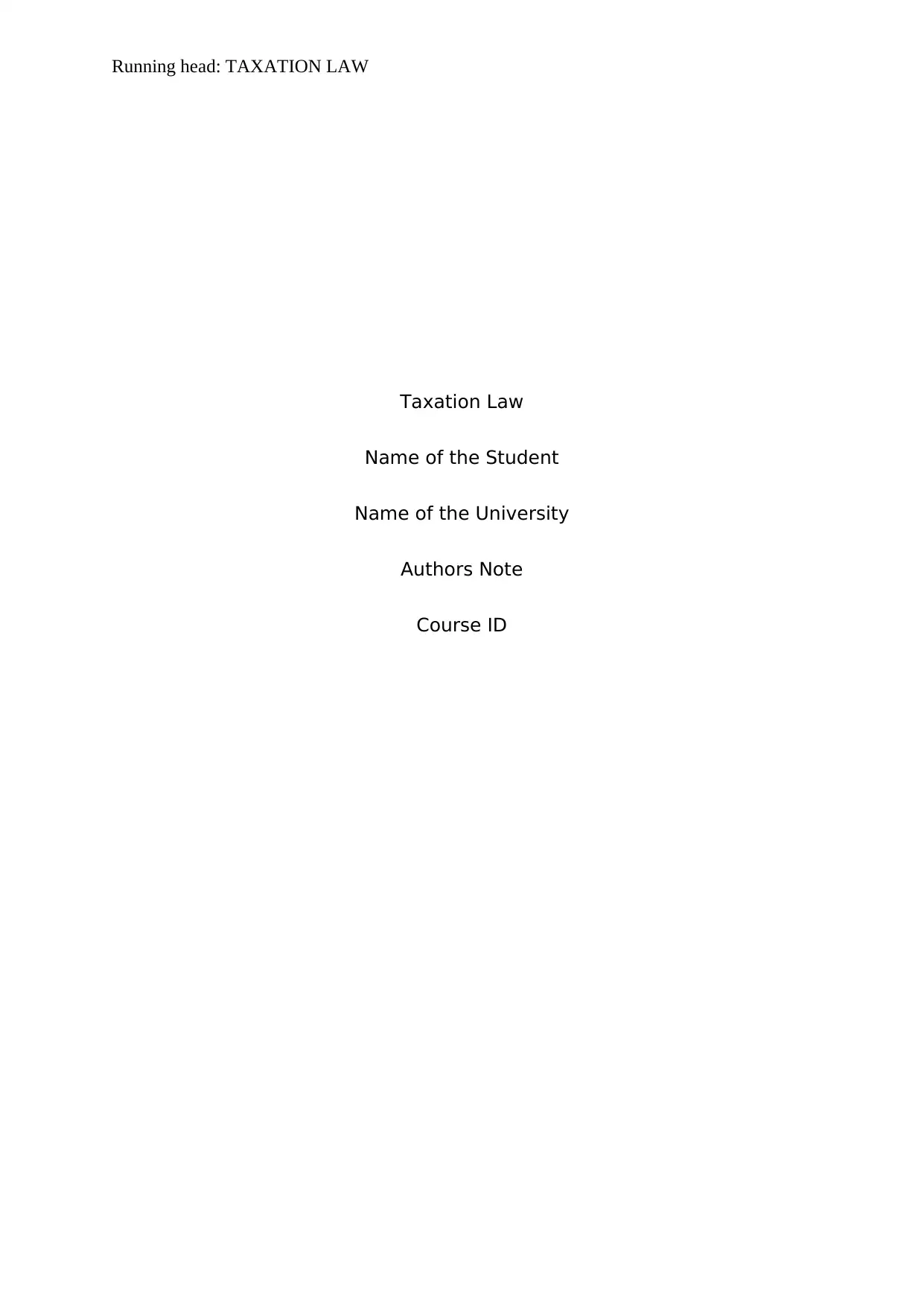
Running head: TAXATION LAW
Taxation Law
Name of the Student
Name of the University
Authors Note
Course ID
Taxation Law
Name of the Student
Name of the University
Authors Note
Course ID
Secure Best Marks with AI Grader
Need help grading? Try our AI Grader for instant feedback on your assignments.

1TAXATION LAW
Table of Contents
Answer to question 1:..................................................................................2
Answer to requirement (I):..........................................................................2
Introduction:................................................................................................2
The domicile Test:.......................................................................................3
The 183-Day test:........................................................................................3
Superannuation test:...................................................................................4
Conclusion:..................................................................................................4
Answer to requirement (II):.........................................................................5
Answer to question 2:..................................................................................5
Answer to requirement (I):..........................................................................5
Salary and superannuation benefit of Joyce:...............................................6
Payment of school fees:..............................................................................7
Expenditure on travelling:...........................................................................7
Membership Cost:........................................................................................7
Payment of Mobile Phone and Loan:...........................................................8
Car fringe benefit:.......................................................................................8
Conclusion:..................................................................................................9
Answer to requirement (II):.........................................................................9
Table of Contents
Answer to question 1:..................................................................................2
Answer to requirement (I):..........................................................................2
Introduction:................................................................................................2
The domicile Test:.......................................................................................3
The 183-Day test:........................................................................................3
Superannuation test:...................................................................................4
Conclusion:..................................................................................................4
Answer to requirement (II):.........................................................................5
Answer to question 2:..................................................................................5
Answer to requirement (I):..........................................................................5
Salary and superannuation benefit of Joyce:...............................................6
Payment of school fees:..............................................................................7
Expenditure on travelling:...........................................................................7
Membership Cost:........................................................................................7
Payment of Mobile Phone and Loan:...........................................................8
Car fringe benefit:.......................................................................................8
Conclusion:..................................................................................................9
Answer to requirement (II):.........................................................................9
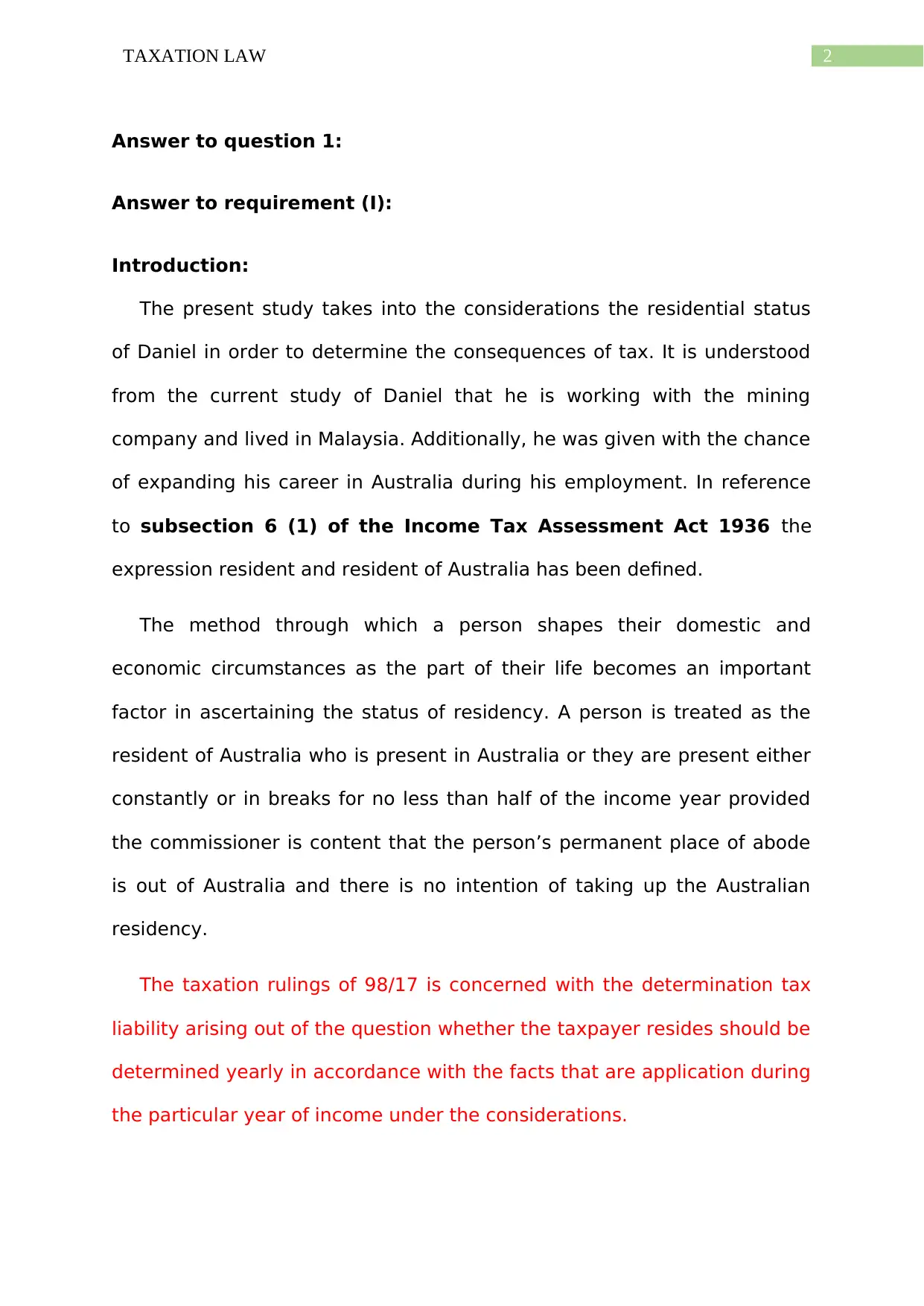
2TAXATION LAW
Answer to question 1:
Answer to requirement (I):
Introduction:
The present study takes into the considerations the residential status
of Daniel in order to determine the consequences of tax. It is understood
from the current study of Daniel that he is working with the mining
company and lived in Malaysia. Additionally, he was given with the chance
of expanding his career in Australia during his employment. In reference
to subsection 6 (1) of the Income Tax Assessment Act 1936 the
expression resident and resident of Australia has been defined.
The method through which a person shapes their domestic and
economic circumstances as the part of their life becomes an important
factor in ascertaining the status of residency. A person is treated as the
resident of Australia who is present in Australia or they are present either
constantly or in breaks for no less than half of the income year provided
the commissioner is content that the person’s permanent place of abode
is out of Australia and there is no intention of taking up the Australian
residency.
The taxation rulings of 98/17 is concerned with the determination tax
liability arising out of the question whether the taxpayer resides should be
determined yearly in accordance with the facts that are application during
the particular year of income under the considerations.
Answer to question 1:
Answer to requirement (I):
Introduction:
The present study takes into the considerations the residential status
of Daniel in order to determine the consequences of tax. It is understood
from the current study of Daniel that he is working with the mining
company and lived in Malaysia. Additionally, he was given with the chance
of expanding his career in Australia during his employment. In reference
to subsection 6 (1) of the Income Tax Assessment Act 1936 the
expression resident and resident of Australia has been defined.
The method through which a person shapes their domestic and
economic circumstances as the part of their life becomes an important
factor in ascertaining the status of residency. A person is treated as the
resident of Australia who is present in Australia or they are present either
constantly or in breaks for no less than half of the income year provided
the commissioner is content that the person’s permanent place of abode
is out of Australia and there is no intention of taking up the Australian
residency.
The taxation rulings of 98/17 is concerned with the determination tax
liability arising out of the question whether the taxpayer resides should be
determined yearly in accordance with the facts that are application during
the particular year of income under the considerations.
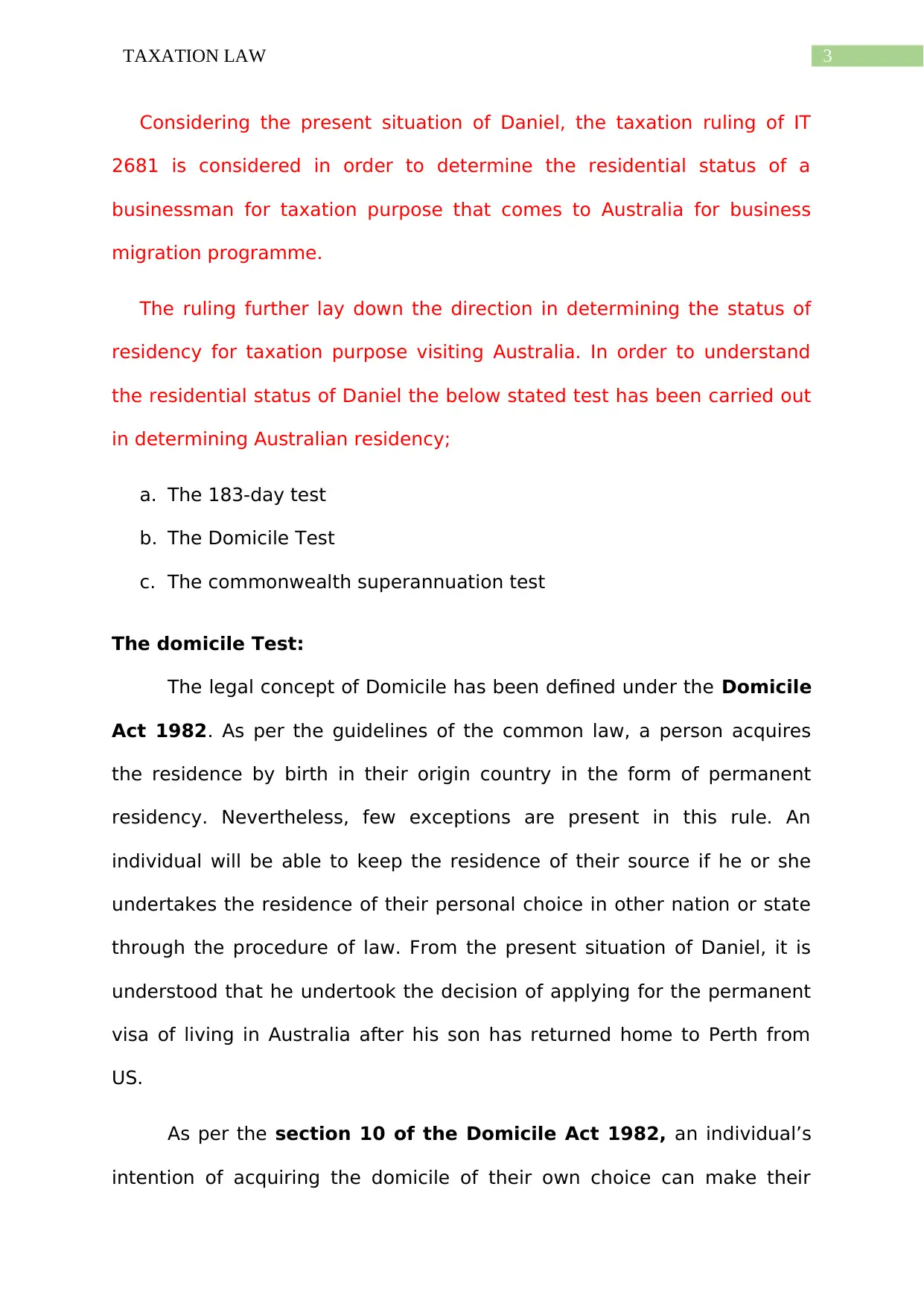
3TAXATION LAW
Considering the present situation of Daniel, the taxation ruling of IT
2681 is considered in order to determine the residential status of a
businessman for taxation purpose that comes to Australia for business
migration programme.
The ruling further lay down the direction in determining the status of
residency for taxation purpose visiting Australia. In order to understand
the residential status of Daniel the below stated test has been carried out
in determining Australian residency;
a. The 183-day test
b. The Domicile Test
c. The commonwealth superannuation test
The domicile Test:
The legal concept of Domicile has been defined under the Domicile
Act 1982. As per the guidelines of the common law, a person acquires
the residence by birth in their origin country in the form of permanent
residency. Nevertheless, few exceptions are present in this rule. An
individual will be able to keep the residence of their source if he or she
undertakes the residence of their personal choice in other nation or state
through the procedure of law. From the present situation of Daniel, it is
understood that he undertook the decision of applying for the permanent
visa of living in Australia after his son has returned home to Perth from
US.
As per the section 10 of the Domicile Act 1982, an individual’s
intention of acquiring the domicile of their own choice can make their
Considering the present situation of Daniel, the taxation ruling of IT
2681 is considered in order to determine the residential status of a
businessman for taxation purpose that comes to Australia for business
migration programme.
The ruling further lay down the direction in determining the status of
residency for taxation purpose visiting Australia. In order to understand
the residential status of Daniel the below stated test has been carried out
in determining Australian residency;
a. The 183-day test
b. The Domicile Test
c. The commonwealth superannuation test
The domicile Test:
The legal concept of Domicile has been defined under the Domicile
Act 1982. As per the guidelines of the common law, a person acquires
the residence by birth in their origin country in the form of permanent
residency. Nevertheless, few exceptions are present in this rule. An
individual will be able to keep the residence of their source if he or she
undertakes the residence of their personal choice in other nation or state
through the procedure of law. From the present situation of Daniel, it is
understood that he undertook the decision of applying for the permanent
visa of living in Australia after his son has returned home to Perth from
US.
As per the section 10 of the Domicile Act 1982, an individual’s
intention of acquiring the domicile of their own choice can make their
Secure Best Marks with AI Grader
Need help grading? Try our AI Grader for instant feedback on your assignments.

4TAXATION LAW
home absolutely. To ascertain the domicile of a person it is vital to take
into the considerations the intention of the person in compliance with
subsection 6 (1) as to where the intention of the person is, to certainty
make their home. Citing the judgement of the full federal court in the case
of Henderson v. Henderson (1965) 1 All E.R. 179 an individual
intentions of undertaking the domicile of their own choice in country is
regarded as vital1.
As understood in the study of Daniel in respect of Domicile Act
1982 he has expressed his intention of residing in Australia by applying
for the permanent visa. In respect of the reference made in the case of
Bell v. Kennedy (1868) it is understood that Daniel intends to take up
the residency according to his personal choice to make his permanent
place indefinitely.
The 183-Day test:
The 183-Day test states that a person have been present in
Australia for no less than half of the year in Australia whether in breaks or
constantly will be treated as Australian resident. However, there is an
exception to this test where the commissioner believes that permanent
place of dwelling is outside of Australia and there is no intention of taking
the residency of Australia. The judgement held in the case of F.C of T v.
Applegate (1979), stated that the concept of place of residence is
important in ascertaining the physical surrounding where an individual
1 Krever, Richard E, Australian Taxation Law Cases 2013 (Thomson Reuters, 2013)
home absolutely. To ascertain the domicile of a person it is vital to take
into the considerations the intention of the person in compliance with
subsection 6 (1) as to where the intention of the person is, to certainty
make their home. Citing the judgement of the full federal court in the case
of Henderson v. Henderson (1965) 1 All E.R. 179 an individual
intentions of undertaking the domicile of their own choice in country is
regarded as vital1.
As understood in the study of Daniel in respect of Domicile Act
1982 he has expressed his intention of residing in Australia by applying
for the permanent visa. In respect of the reference made in the case of
Bell v. Kennedy (1868) it is understood that Daniel intends to take up
the residency according to his personal choice to make his permanent
place indefinitely.
The 183-Day test:
The 183-Day test states that a person have been present in
Australia for no less than half of the year in Australia whether in breaks or
constantly will be treated as Australian resident. However, there is an
exception to this test where the commissioner believes that permanent
place of dwelling is outside of Australia and there is no intention of taking
the residency of Australia. The judgement held in the case of F.C of T v.
Applegate (1979), stated that the concept of place of residence is
important in ascertaining the physical surrounding where an individual
1 Krever, Richard E, Australian Taxation Law Cases 2013 (Thomson Reuters, 2013)
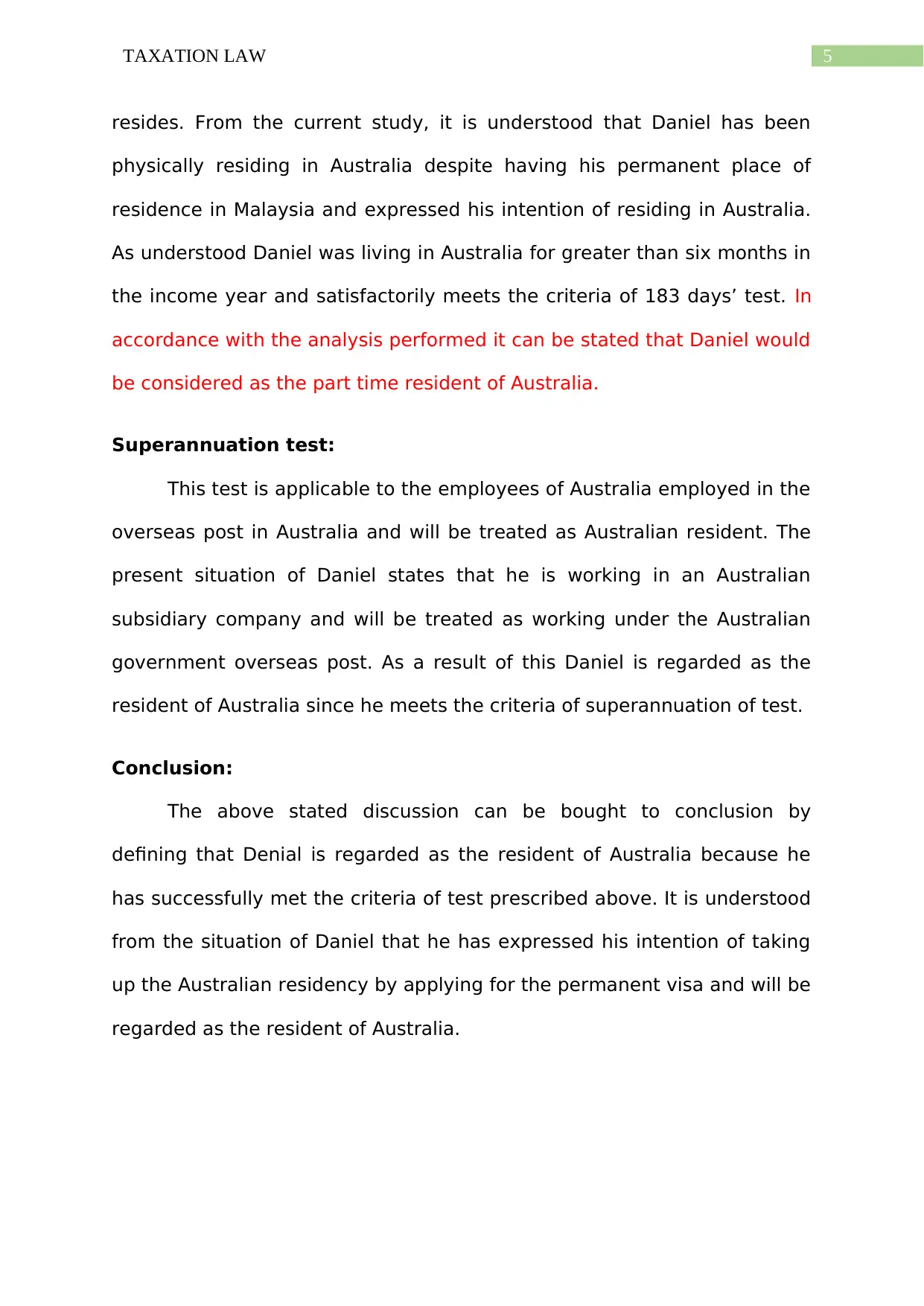
5TAXATION LAW
resides. From the current study, it is understood that Daniel has been
physically residing in Australia despite having his permanent place of
residence in Malaysia and expressed his intention of residing in Australia.
As understood Daniel was living in Australia for greater than six months in
the income year and satisfactorily meets the criteria of 183 days’ test. In
accordance with the analysis performed it can be stated that Daniel would
be considered as the part time resident of Australia.
Superannuation test:
This test is applicable to the employees of Australia employed in the
overseas post in Australia and will be treated as Australian resident. The
present situation of Daniel states that he is working in an Australian
subsidiary company and will be treated as working under the Australian
government overseas post. As a result of this Daniel is regarded as the
resident of Australia since he meets the criteria of superannuation of test.
Conclusion:
The above stated discussion can be bought to conclusion by
defining that Denial is regarded as the resident of Australia because he
has successfully met the criteria of test prescribed above. It is understood
from the situation of Daniel that he has expressed his intention of taking
up the Australian residency by applying for the permanent visa and will be
regarded as the resident of Australia.
resides. From the current study, it is understood that Daniel has been
physically residing in Australia despite having his permanent place of
residence in Malaysia and expressed his intention of residing in Australia.
As understood Daniel was living in Australia for greater than six months in
the income year and satisfactorily meets the criteria of 183 days’ test. In
accordance with the analysis performed it can be stated that Daniel would
be considered as the part time resident of Australia.
Superannuation test:
This test is applicable to the employees of Australia employed in the
overseas post in Australia and will be treated as Australian resident. The
present situation of Daniel states that he is working in an Australian
subsidiary company and will be treated as working under the Australian
government overseas post. As a result of this Daniel is regarded as the
resident of Australia since he meets the criteria of superannuation of test.
Conclusion:
The above stated discussion can be bought to conclusion by
defining that Denial is regarded as the resident of Australia because he
has successfully met the criteria of test prescribed above. It is understood
from the situation of Daniel that he has expressed his intention of taking
up the Australian residency by applying for the permanent visa and will be
regarded as the resident of Australia.
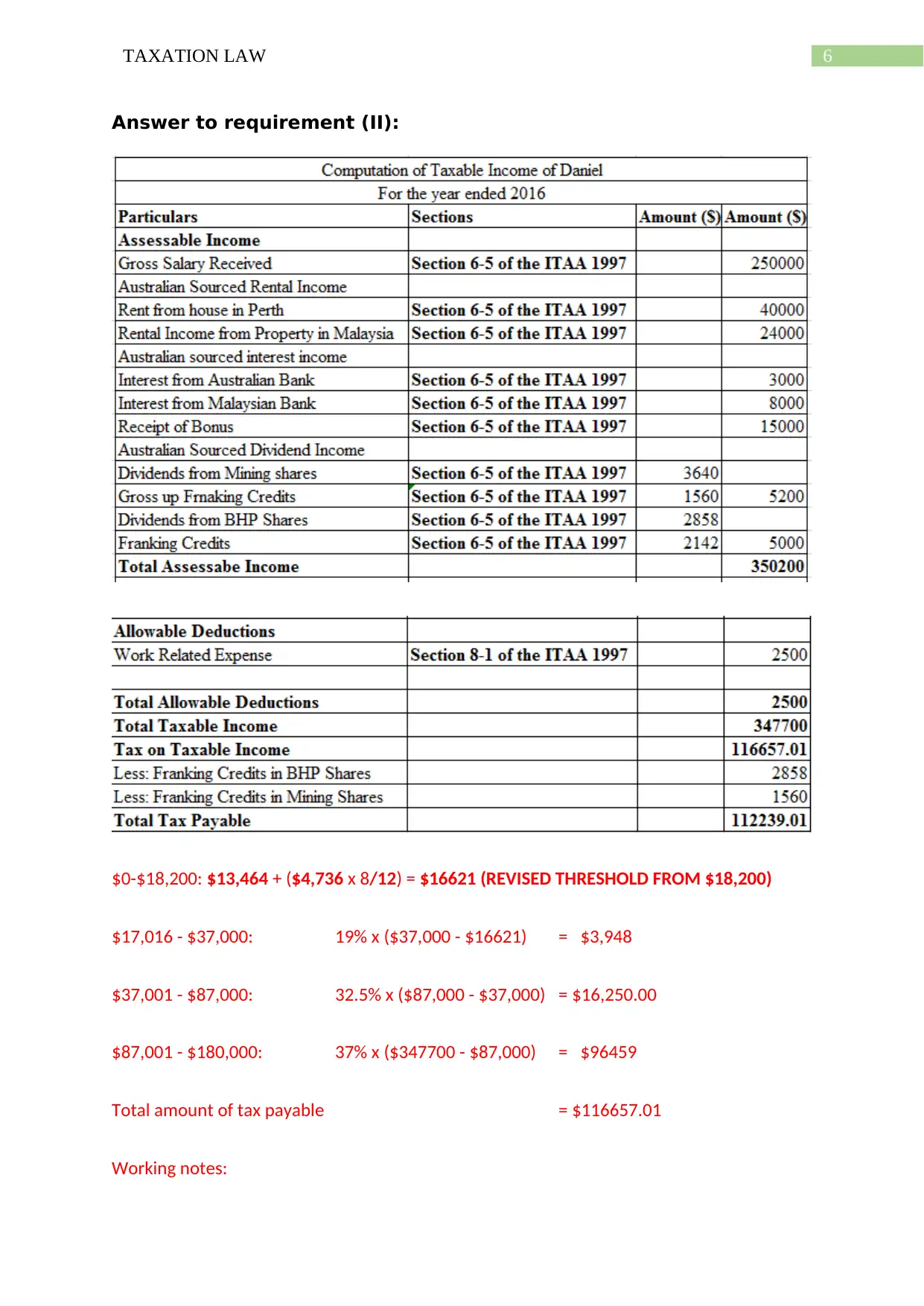
6TAXATION LAW
Answer to requirement (II):
$0-$18,200: $13,464 + ($4,736 x 8/12) = $16621 (REVISED THRESHOLD FROM $18,200)
$17,016 - $37,000: 19% x ($37,000 - $16621) = $3,948
$37,001 - $87,000: 32.5% x ($87,000 - $37,000) = $16,250.00
$87,001 - $180,000: 37% x ($347700 - $87,000) = $96459
Total amount of tax payable = $116657.01
Working notes:
Answer to requirement (II):
$0-$18,200: $13,464 + ($4,736 x 8/12) = $16621 (REVISED THRESHOLD FROM $18,200)
$17,016 - $37,000: 19% x ($37,000 - $16621) = $3,948
$37,001 - $87,000: 32.5% x ($87,000 - $37,000) = $16,250.00
$87,001 - $180,000: 37% x ($347700 - $87,000) = $96459
Total amount of tax payable = $116657.01
Working notes:
Paraphrase This Document
Need a fresh take? Get an instant paraphrase of this document with our AI Paraphraser
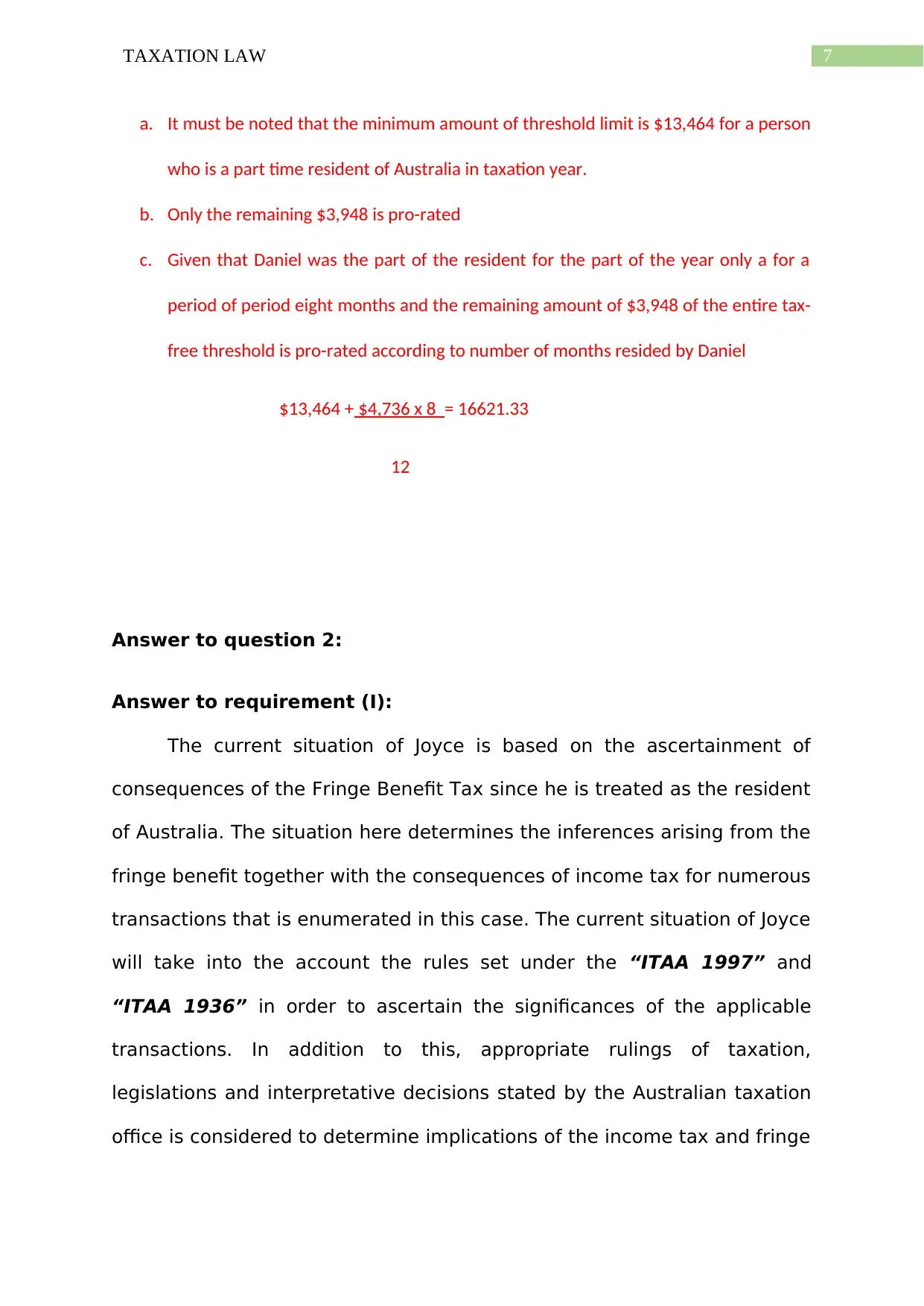
7TAXATION LAW
a. It must be noted that the minimum amount of threshold limit is $13,464 for a person
who is a part time resident of Australia in taxation year.
b. Only the remaining $3,948 is pro-rated
c. Given that Daniel was the part of the resident for the part of the year only a for a
period of period eight months and the remaining amount of $3,948 of the entire tax-
free threshold is pro-rated according to number of months resided by Daniel
$13,464 + $4,736 x 8 = 16621.33
12
Answer to question 2:
Answer to requirement (I):
The current situation of Joyce is based on the ascertainment of
consequences of the Fringe Benefit Tax since he is treated as the resident
of Australia. The situation here determines the inferences arising from the
fringe benefit together with the consequences of income tax for numerous
transactions that is enumerated in this case. The current situation of Joyce
will take into the account the rules set under the “ITAA 1997” and
“ITAA 1936” in order to ascertain the significances of the applicable
transactions. In addition to this, appropriate rulings of taxation,
legislations and interpretative decisions stated by the Australian taxation
office is considered to determine implications of the income tax and fringe
a. It must be noted that the minimum amount of threshold limit is $13,464 for a person
who is a part time resident of Australia in taxation year.
b. Only the remaining $3,948 is pro-rated
c. Given that Daniel was the part of the resident for the part of the year only a for a
period of period eight months and the remaining amount of $3,948 of the entire tax-
free threshold is pro-rated according to number of months resided by Daniel
$13,464 + $4,736 x 8 = 16621.33
12
Answer to question 2:
Answer to requirement (I):
The current situation of Joyce is based on the ascertainment of
consequences of the Fringe Benefit Tax since he is treated as the resident
of Australia. The situation here determines the inferences arising from the
fringe benefit together with the consequences of income tax for numerous
transactions that is enumerated in this case. The current situation of Joyce
will take into the account the rules set under the “ITAA 1997” and
“ITAA 1936” in order to ascertain the significances of the applicable
transactions. In addition to this, appropriate rulings of taxation,
legislations and interpretative decisions stated by the Australian taxation
office is considered to determine implications of the income tax and fringe
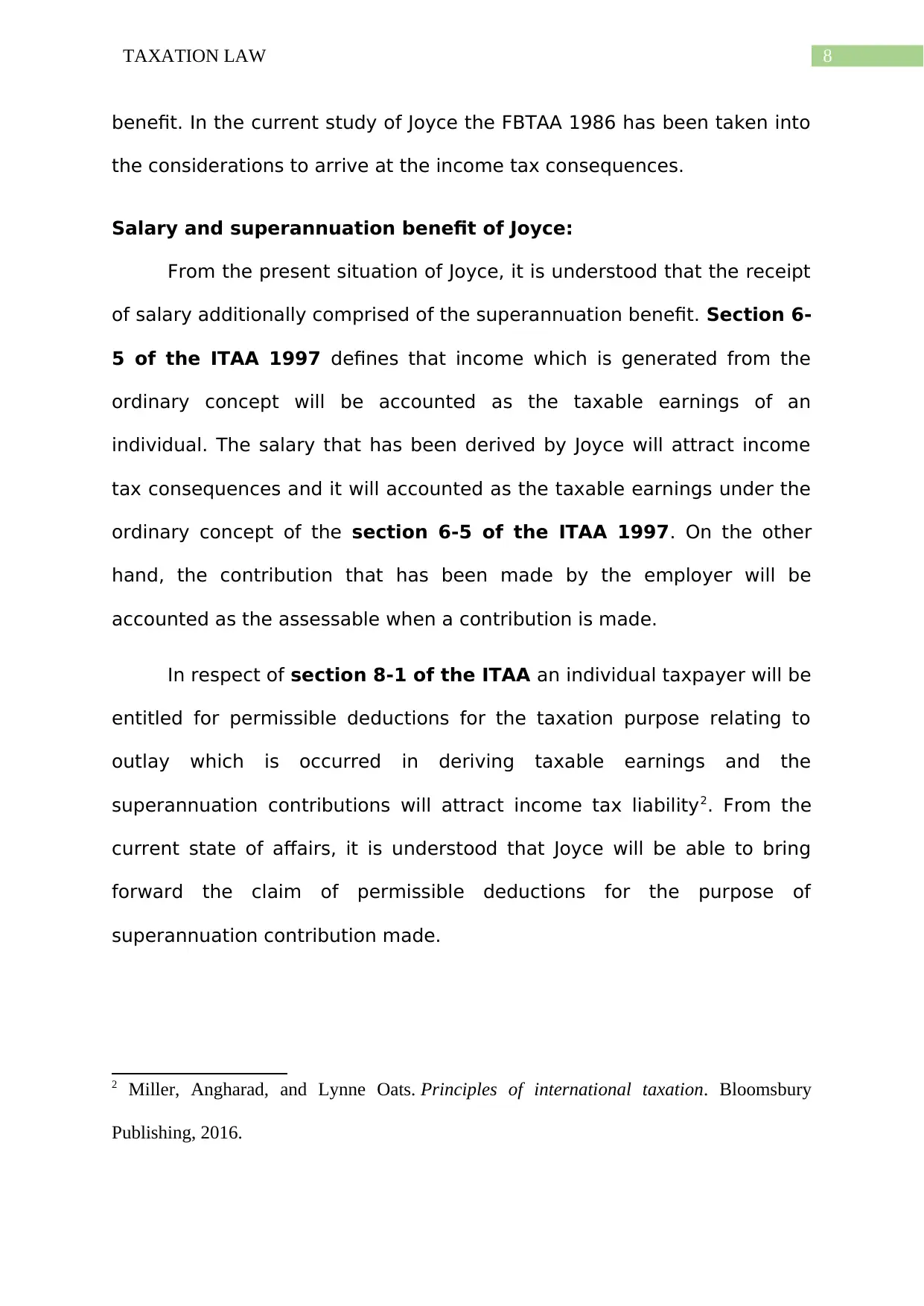
8TAXATION LAW
benefit. In the current study of Joyce the FBTAA 1986 has been taken into
the considerations to arrive at the income tax consequences.
Salary and superannuation benefit of Joyce:
From the present situation of Joyce, it is understood that the receipt
of salary additionally comprised of the superannuation benefit. Section 6-
5 of the ITAA 1997 defines that income which is generated from the
ordinary concept will be accounted as the taxable earnings of an
individual. The salary that has been derived by Joyce will attract income
tax consequences and it will accounted as the taxable earnings under the
ordinary concept of the section 6-5 of the ITAA 1997. On the other
hand, the contribution that has been made by the employer will be
accounted as the assessable when a contribution is made.
In respect of section 8-1 of the ITAA an individual taxpayer will be
entitled for permissible deductions for the taxation purpose relating to
outlay which is occurred in deriving taxable earnings and the
superannuation contributions will attract income tax liability2. From the
current state of affairs, it is understood that Joyce will be able to bring
forward the claim of permissible deductions for the purpose of
superannuation contribution made.
2 Miller, Angharad, and Lynne Oats. Principles of international taxation. Bloomsbury
Publishing, 2016.
benefit. In the current study of Joyce the FBTAA 1986 has been taken into
the considerations to arrive at the income tax consequences.
Salary and superannuation benefit of Joyce:
From the present situation of Joyce, it is understood that the receipt
of salary additionally comprised of the superannuation benefit. Section 6-
5 of the ITAA 1997 defines that income which is generated from the
ordinary concept will be accounted as the taxable earnings of an
individual. The salary that has been derived by Joyce will attract income
tax consequences and it will accounted as the taxable earnings under the
ordinary concept of the section 6-5 of the ITAA 1997. On the other
hand, the contribution that has been made by the employer will be
accounted as the assessable when a contribution is made.
In respect of section 8-1 of the ITAA an individual taxpayer will be
entitled for permissible deductions for the taxation purpose relating to
outlay which is occurred in deriving taxable earnings and the
superannuation contributions will attract income tax liability2. From the
current state of affairs, it is understood that Joyce will be able to bring
forward the claim of permissible deductions for the purpose of
superannuation contribution made.
2 Miller, Angharad, and Lynne Oats. Principles of international taxation. Bloomsbury
Publishing, 2016.

9TAXATION LAW
Payment of school fees:
The fringe benefit tax will be applied for the benefit that is given to
the employee from the employer for their family benefit or other
associates. Such benefit provided to the employee usually becomes the
share of salary and wages. As understood from the current situation of
Joyce, it is found that the employer of Joyce paid the fees of school for
Joyce children. Hence, an assertion can be bought forward that school
fees paid will be treated as the fringe benefit which will be having tax
liability.
Expenditure on travelling:
The ruling of TR 2017/D6 states the situations when an expense
that is occurred by the taxpayer on traveling will be treated for allowable
deductions. The ruling states the guidelines for ascertaining whether a
person will be entitled for bringing forward the claim of allowable
deductions for incurrence of travelling expenditure derived under section
8-1 of the ITAA 1997. Section 8-1 of the ITAA 1997 brings forward
that outlay or expense occurred at the time of performing the work of
employee with no part of the expenses is occurred for personal, capital or
domestic form will be wholly treated for allowable deductions. The
expenses occurred in the present situation by Joyce will be treated as
wholly for allowable deductions in respect of section 8-1 of the ITAA
1997. Travelling cost incurred on 6 potential client by liable for income
tax deductions since these expenses were entirely incurred on gaining
assessable income.
Payment of school fees:
The fringe benefit tax will be applied for the benefit that is given to
the employee from the employer for their family benefit or other
associates. Such benefit provided to the employee usually becomes the
share of salary and wages. As understood from the current situation of
Joyce, it is found that the employer of Joyce paid the fees of school for
Joyce children. Hence, an assertion can be bought forward that school
fees paid will be treated as the fringe benefit which will be having tax
liability.
Expenditure on travelling:
The ruling of TR 2017/D6 states the situations when an expense
that is occurred by the taxpayer on traveling will be treated for allowable
deductions. The ruling states the guidelines for ascertaining whether a
person will be entitled for bringing forward the claim of allowable
deductions for incurrence of travelling expenditure derived under section
8-1 of the ITAA 1997. Section 8-1 of the ITAA 1997 brings forward
that outlay or expense occurred at the time of performing the work of
employee with no part of the expenses is occurred for personal, capital or
domestic form will be wholly treated for allowable deductions. The
expenses occurred in the present situation by Joyce will be treated as
wholly for allowable deductions in respect of section 8-1 of the ITAA
1997. Travelling cost incurred on 6 potential client by liable for income
tax deductions since these expenses were entirely incurred on gaining
assessable income.
Secure Best Marks with AI Grader
Need help grading? Try our AI Grader for instant feedback on your assignments.
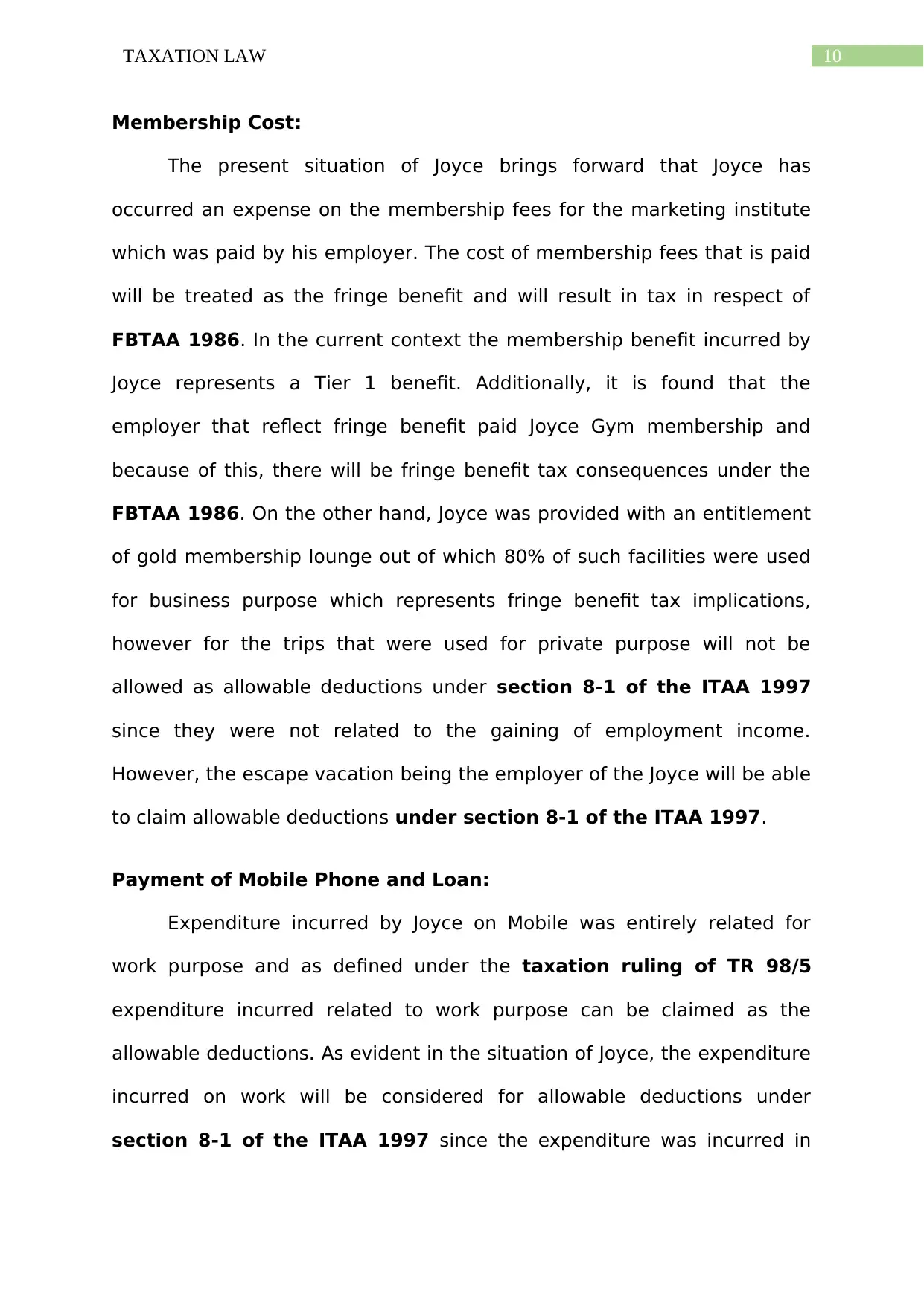
10TAXATION LAW
Membership Cost:
The present situation of Joyce brings forward that Joyce has
occurred an expense on the membership fees for the marketing institute
which was paid by his employer. The cost of membership fees that is paid
will be treated as the fringe benefit and will result in tax in respect of
FBTAA 1986. In the current context the membership benefit incurred by
Joyce represents a Tier 1 benefit. Additionally, it is found that the
employer that reflect fringe benefit paid Joyce Gym membership and
because of this, there will be fringe benefit tax consequences under the
FBTAA 1986. On the other hand, Joyce was provided with an entitlement
of gold membership lounge out of which 80% of such facilities were used
for business purpose which represents fringe benefit tax implications,
however for the trips that were used for private purpose will not be
allowed as allowable deductions under section 8-1 of the ITAA 1997
since they were not related to the gaining of employment income.
However, the escape vacation being the employer of the Joyce will be able
to claim allowable deductions under section 8-1 of the ITAA 1997.
Payment of Mobile Phone and Loan:
Expenditure incurred by Joyce on Mobile was entirely related for
work purpose and as defined under the taxation ruling of TR 98/5
expenditure incurred related to work purpose can be claimed as the
allowable deductions. As evident in the situation of Joyce, the expenditure
incurred on work will be considered for allowable deductions under
section 8-1 of the ITAA 1997 since the expenditure was incurred in
Membership Cost:
The present situation of Joyce brings forward that Joyce has
occurred an expense on the membership fees for the marketing institute
which was paid by his employer. The cost of membership fees that is paid
will be treated as the fringe benefit and will result in tax in respect of
FBTAA 1986. In the current context the membership benefit incurred by
Joyce represents a Tier 1 benefit. Additionally, it is found that the
employer that reflect fringe benefit paid Joyce Gym membership and
because of this, there will be fringe benefit tax consequences under the
FBTAA 1986. On the other hand, Joyce was provided with an entitlement
of gold membership lounge out of which 80% of such facilities were used
for business purpose which represents fringe benefit tax implications,
however for the trips that were used for private purpose will not be
allowed as allowable deductions under section 8-1 of the ITAA 1997
since they were not related to the gaining of employment income.
However, the escape vacation being the employer of the Joyce will be able
to claim allowable deductions under section 8-1 of the ITAA 1997.
Payment of Mobile Phone and Loan:
Expenditure incurred by Joyce on Mobile was entirely related for
work purpose and as defined under the taxation ruling of TR 98/5
expenditure incurred related to work purpose can be claimed as the
allowable deductions. As evident in the situation of Joyce, the expenditure
incurred on work will be considered for allowable deductions under
section 8-1 of the ITAA 1997 since the expenditure was incurred in
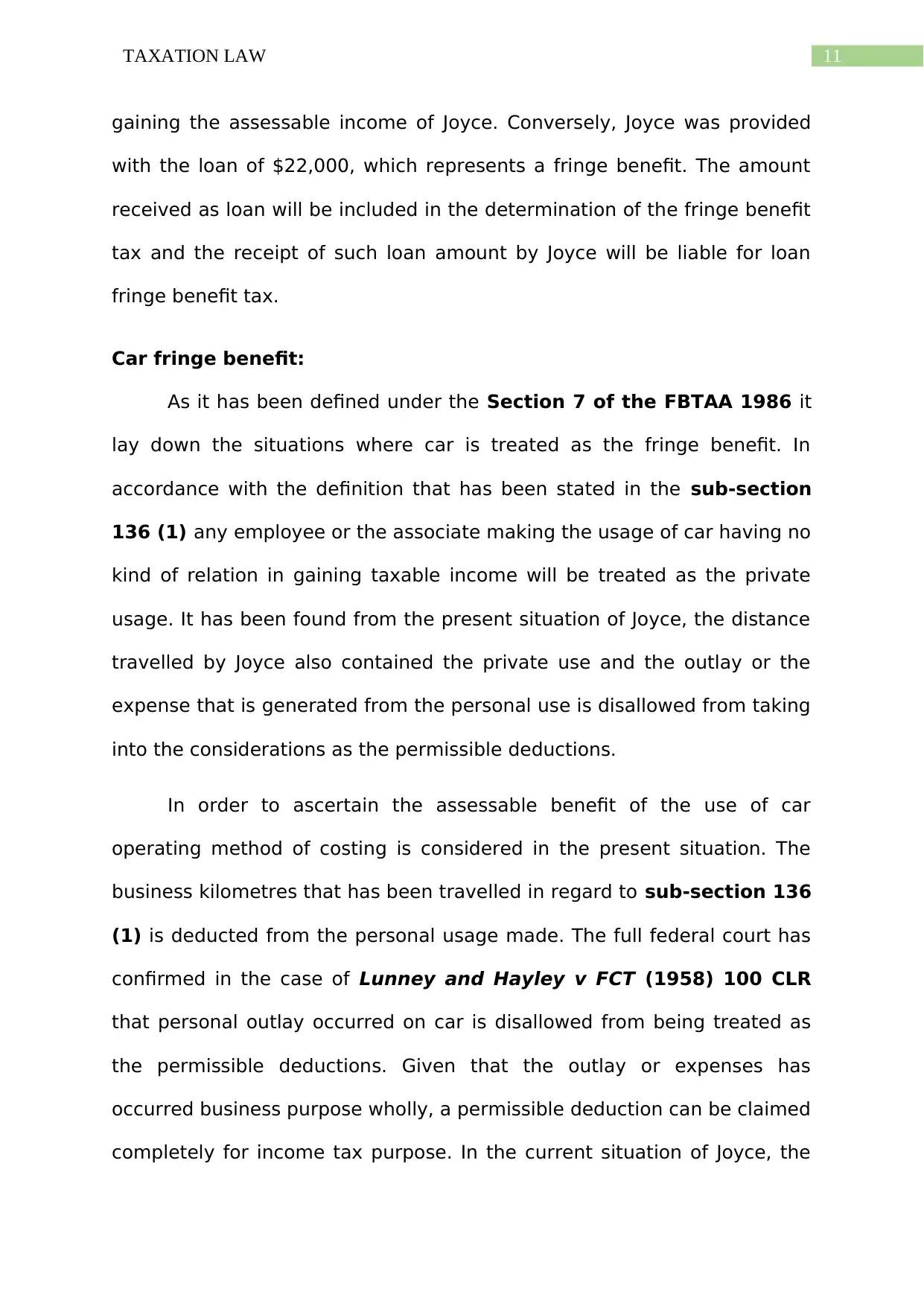
11TAXATION LAW
gaining the assessable income of Joyce. Conversely, Joyce was provided
with the loan of $22,000, which represents a fringe benefit. The amount
received as loan will be included in the determination of the fringe benefit
tax and the receipt of such loan amount by Joyce will be liable for loan
fringe benefit tax.
Car fringe benefit:
As it has been defined under the Section 7 of the FBTAA 1986 it
lay down the situations where car is treated as the fringe benefit. In
accordance with the definition that has been stated in the sub-section
136 (1) any employee or the associate making the usage of car having no
kind of relation in gaining taxable income will be treated as the private
usage. It has been found from the present situation of Joyce, the distance
travelled by Joyce also contained the private use and the outlay or the
expense that is generated from the personal use is disallowed from taking
into the considerations as the permissible deductions.
In order to ascertain the assessable benefit of the use of car
operating method of costing is considered in the present situation. The
business kilometres that has been travelled in regard to sub-section 136
(1) is deducted from the personal usage made. The full federal court has
confirmed in the case of Lunney and Hayley v FCT (1958) 100 CLR
that personal outlay occurred on car is disallowed from being treated as
the permissible deductions. Given that the outlay or expenses has
occurred business purpose wholly, a permissible deduction can be claimed
completely for income tax purpose. In the current situation of Joyce, the
gaining the assessable income of Joyce. Conversely, Joyce was provided
with the loan of $22,000, which represents a fringe benefit. The amount
received as loan will be included in the determination of the fringe benefit
tax and the receipt of such loan amount by Joyce will be liable for loan
fringe benefit tax.
Car fringe benefit:
As it has been defined under the Section 7 of the FBTAA 1986 it
lay down the situations where car is treated as the fringe benefit. In
accordance with the definition that has been stated in the sub-section
136 (1) any employee or the associate making the usage of car having no
kind of relation in gaining taxable income will be treated as the private
usage. It has been found from the present situation of Joyce, the distance
travelled by Joyce also contained the private use and the outlay or the
expense that is generated from the personal use is disallowed from taking
into the considerations as the permissible deductions.
In order to ascertain the assessable benefit of the use of car
operating method of costing is considered in the present situation. The
business kilometres that has been travelled in regard to sub-section 136
(1) is deducted from the personal usage made. The full federal court has
confirmed in the case of Lunney and Hayley v FCT (1958) 100 CLR
that personal outlay occurred on car is disallowed from being treated as
the permissible deductions. Given that the outlay or expenses has
occurred business purpose wholly, a permissible deduction can be claimed
completely for income tax purpose. In the current situation of Joyce, the
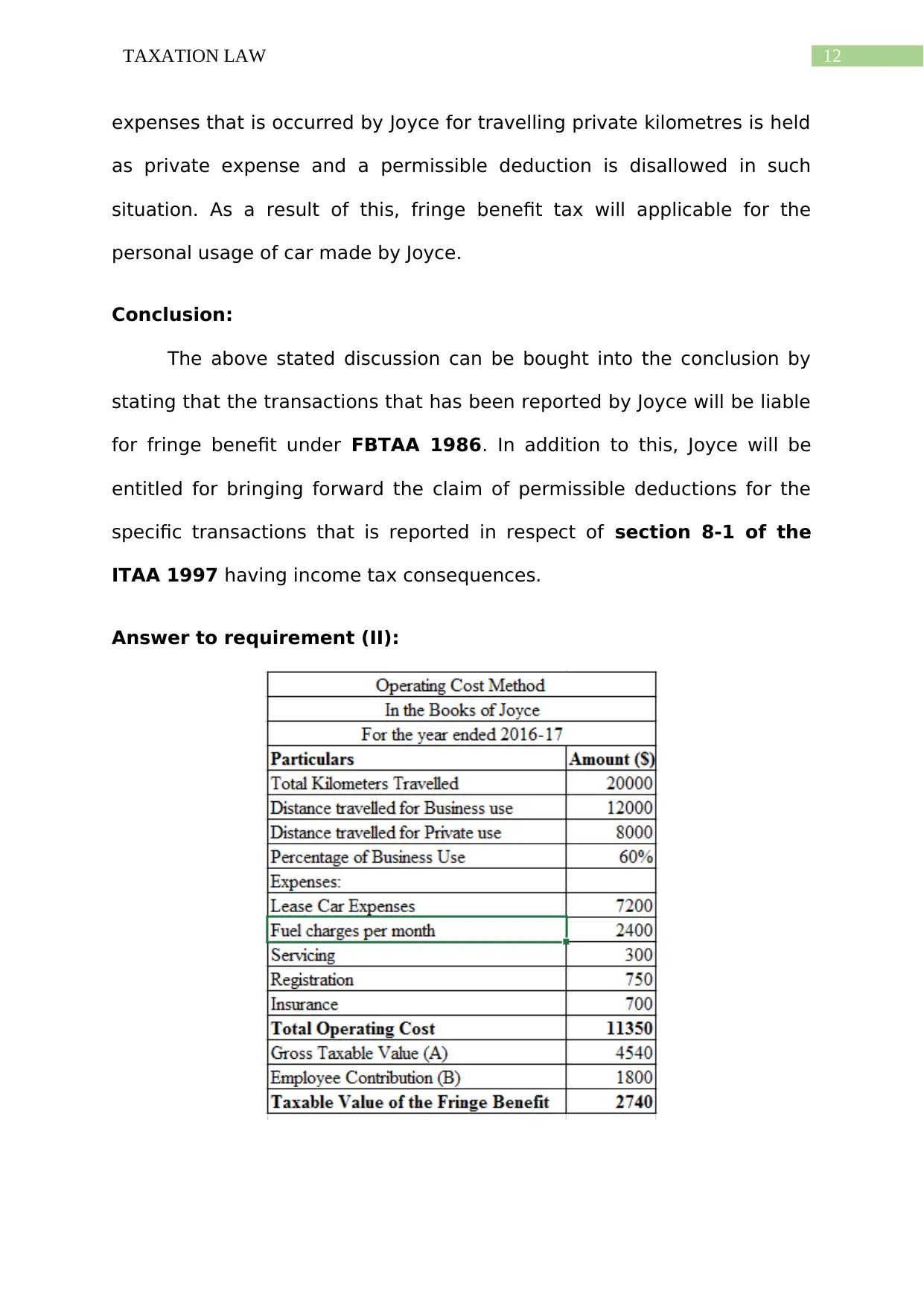
12TAXATION LAW
expenses that is occurred by Joyce for travelling private kilometres is held
as private expense and a permissible deduction is disallowed in such
situation. As a result of this, fringe benefit tax will applicable for the
personal usage of car made by Joyce.
Conclusion:
The above stated discussion can be bought into the conclusion by
stating that the transactions that has been reported by Joyce will be liable
for fringe benefit under FBTAA 1986. In addition to this, Joyce will be
entitled for bringing forward the claim of permissible deductions for the
specific transactions that is reported in respect of section 8-1 of the
ITAA 1997 having income tax consequences.
Answer to requirement (II):
expenses that is occurred by Joyce for travelling private kilometres is held
as private expense and a permissible deduction is disallowed in such
situation. As a result of this, fringe benefit tax will applicable for the
personal usage of car made by Joyce.
Conclusion:
The above stated discussion can be bought into the conclusion by
stating that the transactions that has been reported by Joyce will be liable
for fringe benefit under FBTAA 1986. In addition to this, Joyce will be
entitled for bringing forward the claim of permissible deductions for the
specific transactions that is reported in respect of section 8-1 of the
ITAA 1997 having income tax consequences.
Answer to requirement (II):
Paraphrase This Document
Need a fresh take? Get an instant paraphrase of this document with our AI Paraphraser

13TAXATION LAW
1 out of 14
Related Documents
Your All-in-One AI-Powered Toolkit for Academic Success.
+13062052269
info@desklib.com
Available 24*7 on WhatsApp / Email
![[object Object]](/_next/static/media/star-bottom.7253800d.svg)
Unlock your academic potential
© 2024 | Zucol Services PVT LTD | All rights reserved.





